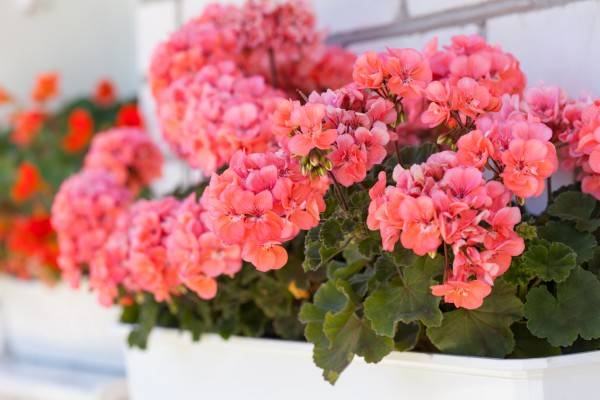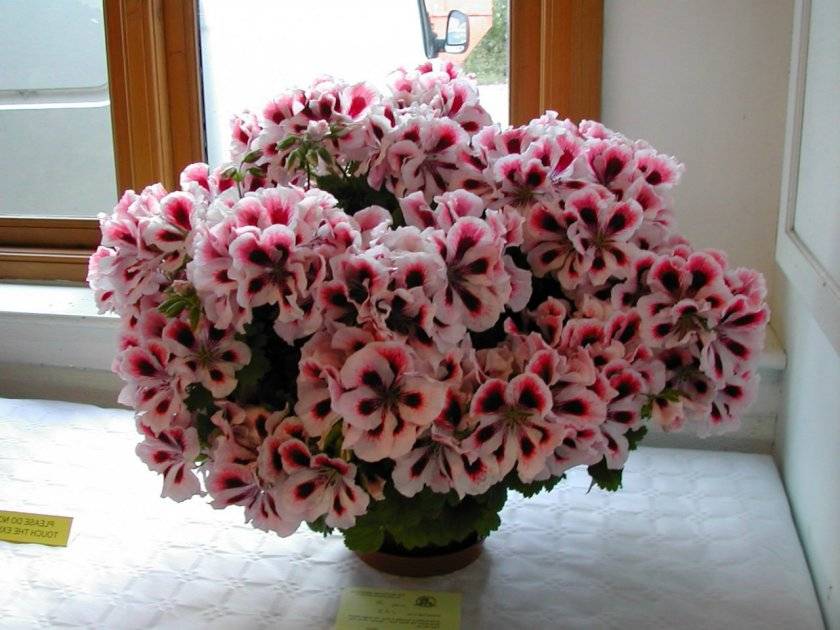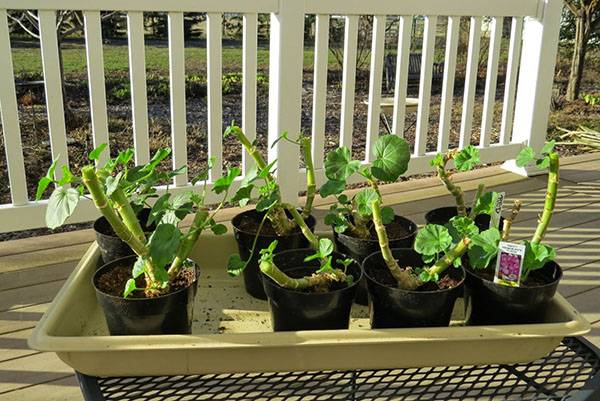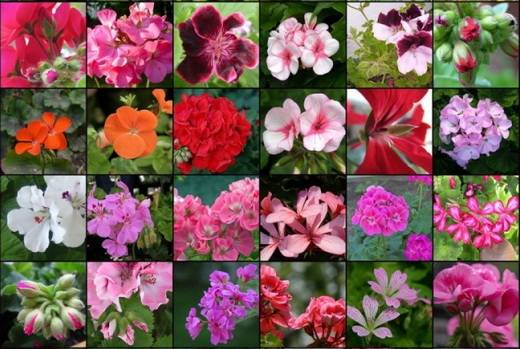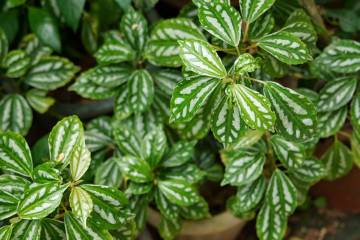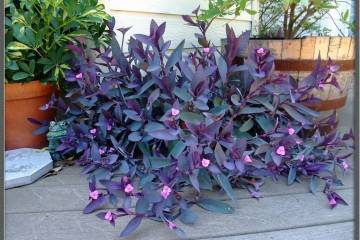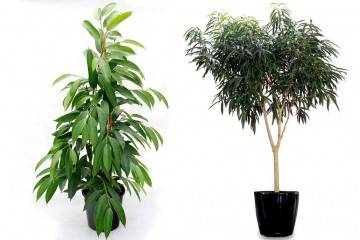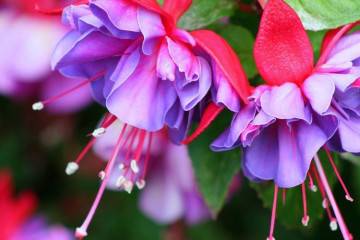Geranium - home care
Content:
Bright red and pink hats can be found everywhere. Geranium has truly filled the windows of houses, hospitals and schools. And all because it is not difficult to grow it, but it blooms for a long time and effectively. There are several secrets on how to care for potted geraniums at home so that they delight the grower.
Geranium - what is this flower
Geranium is a deciduous-flowering ornamental plant. It grows in the form of a shrub, the stems can reach 60 cm. The leaves are palmate-lobed green, sometimes with rounded stripes, fleecy. Inflorescences of different colors are axillary, they are simple, double or semi-double. Flowers are collected in bunches or single.
A beautiful geranium native to South Africa. It has adapted to the four climatic zones of Africa, therefore it has a variety of shapes and colors of inflorescences. Indoor culture was called pelargonium, and the garden version remained geranium. The plant belongs to the Geranev family.
Geranium came to Russia at the end of the 18th century. It quickly spread among the aristocrats and by the beginning of the 19th century. gained great popularity. Pelargonium has adapted to life in the open field in flower beds, and as a wild plant in the middle zone of the country. Wild and indoor geraniums are fundamentally different from each other.
Popular varieties of room geraniums with names
Indoor pelargoniums have more than 300 species. Unique varieties have been bred, distinguished by their appearance, flowering, and aroma of foliage. The most popular ones are:
- the zonal variety is the most common and common variety. Round leaves have a characteristic dark stripe across the leaf. Zoned geraniums are white, pink, or red;
- royal, or large-leaved, geranium got this name due to the large size of flowers, which reach 8 cm in diameter. Flowers are collected in panicles or spherical bunches. Flowers of a wide variety of colors are terry, with streaks or spots on the petals. Bushes grow up to half a meter in height;
- Geranium variety Angel differs in shape and color of flowers. They are very similar to the viola. Beautiful caps of inflorescences hang from rather long shoots for geraniums. Variety Angel refers to ampelous and is suitable for planting in hanging pots;
- indoor variety Unicum has a beautiful combination of dark stripes and veins, contrasting spots on delicate flower petals. Bushes are small, up to 20 cm in length. Inflorescence caps are compact, bright;
- Fragrant geranium is less attractive in appearance. Its leaves are very different from the usual pelargonium. They are pinnately carved, curly and fluffy and grow on long cuttings. Flowers of standard sizes, collected in a rare panicle. But the aromas of these varieties are very diverse: vanilla, almond, mint, apple, ginger, lemon, rose, strawberry. Moreover, the smell is exuded not by inflorescences, but by fleecy leaves;
- ampel ivy-leaved pelargonium is suitable for decorating summer cottages, gardens and gazebos. The flowering of this beauty continues from spring to late autumn. The greenery is dense and covers the entire length of the shoots, which grow up to a meter in length.
A variety of shapes and colors allows you to choose the most beautiful geraniums. Home care is simple and the same for almost all types.
Home geranium care for beginners
The houseplant geranium may well serve as a gift for a young housewife. She is absolutely unpretentious and very resistant to mistakes in care. Signs of problems can be seen in the absence of flowers, yellow foliage, darkening of the trunk. If you adhere to simple rules for caring for this beauty, there will be no problems with her.
Illumination and temperature conditions
Illumination directly proportionally affects the intensity and duration of pelargonium flowering. Therefore, it is worth choosing a place for it on the western or eastern windows. An unpretentious beauty can grow in shade, but with a loss of decorativeness. Its leaves will be small, rarely planted. The shoots will begin to stretch, and small flowers will bloom at their ends.
In winter, the temperature should not drop below 10 ° C. Optimal for pelargonium in winter is 15 ° С, but not higher than 18 ° С. Such a regime will provide a dormant period for the plant. If there is no way to lower the temperature, the flower needs to be highlighted.
Watering rules and humidity
In the summer, watering is needed regular and moderate. Roots and cuttings are easily exposed to gray rot, which appears with excess moisture. Drainage for geraniums is very important. In the summer, watering is needed 2-3 times a week as the soil dries out. Complete drying out of the soil in the pot is detrimental to the flower.

When watering, you should use a watering can with a long spout so that water does not get on the leaves.
It is necessary to maintain humidity for geraniums in the summer on hot days. Saves wet expanded clay in pallets under the pot. Aqua soil, placed in containers near flower pots, is perfect. Spraying is not suitable for geraniums.
Top dressing and soil quality
To maintain active flowering, you need to help the flower by applying mineral fertilizers. Once every two weeks, and sometimes every 10 days, the flower is fertilized with complex agents containing potassium, phosphorus and nitrogen. Organics are not suitable for this plant. In winter, fertilizing will spoil its decorative effect.
The soil for pelargonium needs a light one that does not retain moisture. If you prepare the substrate yourself, you need to mix garden soil, sand and peat.
An important factor for comfortable growth is the supply of air to the roots. This should be done through good drainage holes and by loosening the soil after watering.
Flower container size
The pot should appear cramped at first glance. It is in such a flower that it will actively and vigorously bloom. If the pot is large, the geranium will build up the root system and greenery, it will not be up to flowering. Also, excess liquid accumulates in a large pot, which provokes rotting of the roots.
Pruning and replanting
Pruning for geraniums is needed in the fall. It is best to cut off the shoots, leaving 3-4 buds. During the winter, geraniums will grow shoots. In the spring, they should be pinched to get a dense bush.
Some growers prune the bush in the spring, after the shoots have stretched out and become bare. Such pruning can cause delayed flowering, as the plant needs time to recover from the procedure. Also, in winter, unnecessary waste of energy reserves is obtained for the growth of shoots, which will eventually be cut off.
Indoor geranium is painful to transplant. It is transplanted only when the roots no longer fit into the pot. It is better to transplant it by transshipment and take a pot with a diameter of 1-2 cm larger.
Features of flowering plants
Geranium blooms profusely and for a long time. With proper care, flowering begins in mid-spring and lasts until late fall. If the plant does not want to bloom, you should pay attention to:
- lighting;
- pot size;
- pruning a bush and pinching shoots;
- the presence of regular feeding;
- irrigation regime so that there is no waterlogging of the soil;
- condition of the soil, its looseness and composition.
If the flower has bloomed, it is important:
- do not change the location of the flower, especially the lighting level;
- maintain the correct watering regime;
- apply mineral fertilizers once every 14 days.
A period of activity and rest
The rest period begins during the cold period. It is better to cut the shoots shorter (up to 3-4 buds). After pruning, fertilization will be superfluous. The flower can be placed in the shade or partial shade. The room temperature is required at 15-18 ° C.
The plant wakes up in February-March. At this time, you can begin to form a bush by pinching young shoots. The watering rate increases. The flower is placed in a sunny place. After the start of the growth of new shoots and leaves, the feeding regime should be resumed.
Types and shape of flowers
Umbrellas of inflorescences with a diameter of 15 cm (and in the royal one more than 20 cm) adorn the entire geranium bush. Ordinary flowers grow up to 2 cm in diameter and are placed in 15-20 pieces. in one umbrella. They are simple, split and terry, it all depends on the variety. The main range of colors is all shades of red, white, less often lilac and purple.
Flower reproduction methods
Pelargonium can be propagated all year round. The easiest way to do this is after the fall pruning. But if you adjust to the resting regime, the best breeding season is spring. This is a time of active growth. Cuttings planted in spring bloom in the same summer.
Propagation by cuttings
For cuttings, you should choose beautiful and healthy shoots. Geranium stalks accumulate moisture, which is why they often rot in water. They should be immediately rooted in the ground. After cutting, they need to dry for about an hour. Next, a small cup with drainage holes is prepared. Suitable soil for rooting is loose peat and vermiculite.
Seed propagation
Pelargonium seeds are distinguished by good germination and vitality. It takes more time and patience to grow a bush from seeds. Geranium is sown in boxes with a mixture of peat and vermiculite. The boxes are covered with glass and placed in heat (20-22 ° C), protecting them from direct sunlight. Moistening is carried out by spraying the soil.
Growing problems, diseases and pests
Geranium is a fairly hardy plant, it rarely gets sick and is attacked by pests. An analysis of the state of a flower can be carried out by its appearance:
- yellowing of the leaves can have several reasons. If only the edges of the foliage turn yellow, and then begin to dry, the plant does not have enough moisture. If the leaves are yellow and lethargic, on the contrary, there is too much moisture. If the leaves turn yellow from below, and then fall off, the reason is a lack of light;
- dark spots at the base of the stem are a sign of gray rot. Such a plant can no longer be saved, its shoots are cut and get new ones.Gray rot appears due to excess moisture and poor soil ventilation in the pot;
- brown spots may appear on the leaves. This fungal disease is rust. Infected leaves are removed, and the flower is treated with a 5% solution of Bordeaux liquid;
- if a whitefly, aphid or a tick was seen on the leaves, you should wash the leaves and treat the greens with special means.
If signs of disease are detected and after their treatment, attention should be paid to the conditions of the plant.
How to deal with them
The appearance of diseases or pests is a sign of improper care. Therefore, it is necessary to establish a mode of irrigation, lighting, top dressing. You should also pay attention to drainage, soil quality and pot size.
The beautiful geranium is not a grandmother's flower at all. It can be a decoration for an apartment, a gazebo and a summer flower bed. Its unpretentiousness and spectacular flowering deserve the attention and love of flower growers.
